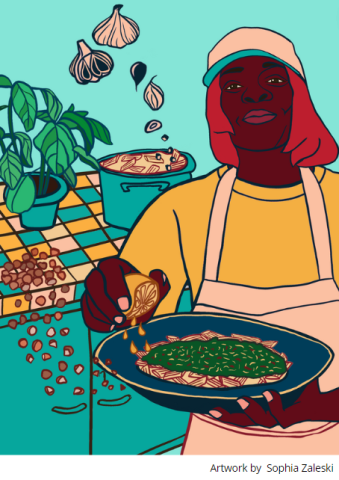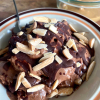Ms. Carolyn came to Food Shift’s Culinary Training Program with years of experience working in catering and concessions but wanted to fine-tune her knife skills and learn about cooking with vegetables. Her positive energy is infectious and she is known for her entertaining sayings.
“When I came to the Food Shift Kitchen I already loved pesto (I think it’s the best taste in the world), but I’d never tried adding hazelnuts before. The lemon juice in the pesto makes it pop off and the hazelnuts give it a little kick. It’s just the bomb. Slap your pesto on pasta, sandwiches, chicken—anything!
I last made this dish for my granddaughter’s birthday. I really wanted my family to taste the pesto, because they weren’t into this kind of stuff. But they are now! They loved it and wanted the recipe. I sent each of my family members home with a little container of pesto and told them to add it to anything.
At Food Shift, I loved coming into the kitchen every day. It was my first time working with female chefs, and unlike the male chefs I worked with before, they weren’t hollering and screaming at me. Chef Suzy and Chef Jen understood me—they were on my level. They understood all that was going on in my personal life, and how my personal life was also my kitchen life. They helped me through a lot. They listened to me and they always had my back.
The Kitchen brought me back to life. Coming into work every day got me back up on my feet. I loved it! The Kitchen program is needed in the community. It’s needed for real.”
Pesto Pasta Recipe
Serves 4
Ms. Carolyn used hazelnuts in her recipe, but pesto is very versatile. Substituting different types of nuts, seeds, and herbs is encouraged. We’re giving specific instructions here on how to work with hazelnuts, but these are also ideas for other pesto combinations: cilantro/pistachio, spinach/walnut, and parsley/pumpkin seed.
INGREDIENTS:
- ½ cup hazelnuts or other nuts/seeds (see note below)
- 2 cloves garlic, peeled
- 1 cup loosely packed basil, about 1 bunch and leaves only, rinsed and pat dry (save the stems, see notes below)
- ½ tsp lemon zest
- 1 Tbsp lemon juice
- ½ tsp salt, plus more to taste
- ¼ tsp black pepper
- ¾ cup olive oil
- 1 8 oz. package of pasta of your choice
- Optional: grated parmesan or other cheese
INSTRUCTIONS:
-
Preheat the oven to 350°F. You can actually put the nuts in the oven as the oven is preheating. Just keep a close eye on them
-
Place hazelnuts on a parchment-lined baking sheet. Roast hazelnuts in the oven for 5 minutes, then remove and stir. Return to the oven and roast about 7 minutes more until nuts are golden brown and fragrant.
-
Wrap the roasted hazelnuts in a clean kitchen towel. Rub nuts in the towel to remove loose skins and let cool (it’s okay if there are small amounts of skin left). Discard the skins in the compost.
-
Place garlic on a cutting board and smash garlic with the flat side of your knife. Sprinkle with a large pinch of salt and still using the flat side of the knife, work the salt and garlic together to form a paste.
-
Finely chop the hazelnuts by using a food processor, hand blender, mortar and pestle, or a knife. Combine the nuts with the garlic paste and add in the basil, lemon zest and juice, salt, and pepper and continue to chop until the ingredients have formed a paste. Slowly pour in olive oil and mix until the mixture is a smooth texture. Taste and adjust the seasoning.
-
Cook pasta in salted water until al dente (Italian for “to the tooth,” meaning tender but firm when bitten). Reserve ½ cup of the pasta water before draining the pasta. Return the pasta to the pot and toss with the pesto and ¼ cup of the reserved cooking water. Add more cooking water as necessary to loosen the sauce. Taste the pasta and add more salt and lemon, if desired. Garnish with cheese if desired.
Ms. Carolyn’s Tips:
- Serve it with a side of garlic bread!
- You can add meat or veggies, anything you like, into this dish, so don’t be afraid to get creative!
- Freeze your pesto and pull it out real quick whenever you want to use some. Just be sure to treat it right: put it in a freezer-safe sealed container and drizzle a layer of oil on top to keep it from turning brown.
Maximizing Your Food
Use less water to cook the pasta: pasta can be cooked in a small amount of water that starts out cold. Salt about 2 quarts (8 cups) of water, put the pasta in the pot, and bring to a boil, stirring frequently so the noodles don’t stick. Once the water boils, reduce to a simmer, and cook about 10 minutes until the pasta is al dente. Remember to save the pasta cooking water to add flavor and liquid to the sauce and the starchy water helps the sauce stick to the pasta.
Use all parts of the lemon: lemon zest offers a real pop and brightness to dishes and allows you to incorporate the skin of the lemon, while the juice has a more concentrated lemon flavor and tartness. For zest: use a grater to remove the colorful part of the peel. Be gentle and stop grating when you see the pith (the white part) which can taste bitter.
Rotate the fruit and continue to grate. Place about 1 tsp amounts of zest in ice cube trays and freeze. Once frozen, place the zest “cubes” in a bag or container for future use. The zest has a concentrated flavor and can be used in baked goods like pie crust and muffins, or jam. For juice: roll the fruit on the countertop with slight pressure to get the most juice from your lemon. Cut your lemon in half crosswise and hold half of the lemon in your hand, cut side down. Use your other hand as a strainer and cup it below the lemon, over a bowl. Squeeze letting the juice go through your fingers and catching and discarding the seeds. Place the juice in ice cube trays. Freeze overnight, then place the frozen lemon cubes into a freezer bag to add to recipes or add to a glass of water for a boost of Vitamin C.
Save the stems of your basil or other herbs to flavor soups and stews. Use them like a bay leaf— adding the whole stem, no need to chop—to a soup and simmer. The soup will take on some of the herby taste. Remove the stem before serving. Stems can also be added to hot water or tea to infuse with flavor.
More stories, recipes, tips, and videos from Food Shift:
- Riz's Corn Chowder
- Kim's Bean Burgers
- Connie's Breakfast Frittata
- Danny’s Mushroom "Bacon"
- Lia's Fried Rice
- Food Shift Kitchen Guide
- Affordable Alternatives
Food is often rooted in story. In this monthly blog series, Food Shift, one of our Chef Partners, is amplifying the voices of their culinary training graduates and their community by sharing their stories and adaptable recipes. Stay tuned for more installments.
Portrait Artwork By: Sophia Zaleski
Learn more about Food Shift and their programs to rescue surplus food to fuel their social enterprise kitchen rather than waste away in landfills.












